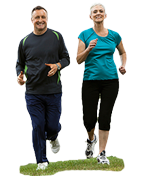Physical Activity
What is Physical Activity?
Physical activity simply means movement of the body that uses energy. Walking, gardening, briskly pushing a baby stroller, climbing the stairs, playing soccer, or dancing the night away are all good examples of being active. For health benefits, physical activity should be moderate or vigorous intensity.
Moderate physical activities include:
- Walking briskly (about 3 ½ miles per hour)
- Bicycling (less than 10 miles per hour)
- General gardening (raking, trimming shrubs)
- Dancing
- Golf (walking and carrying clubs)
- Water aerobics
- Canoeing
- Tennis (doubles)
Vigorous physical activities include: 
- Running/jogging (5 miles per hour)
- Walking very fast (4 ½ miles per hour)
- Bicycling (more than 10 miles per hour)
- Heavy yard work, such as chopping wood
- Swimming (freestyle laps)
- Aerobics
- Basketball (competitive)
- Tennis (singles)
You can choose moderate or vigorous intensity activities, or a mix of both each week. Activities can be considered vigorous, moderate, or light in intensity. This depends on the extent to which they make you breathe harder and your heart beat faster.
Only moderate and vigorous intensity activities count toward meeting your physical activity needs. With vigorous activities, you get similar health benefits in half the time it takes you with moderate ones. You can replace some or all of your moderate activity with vigorous activity. Although you are moving, light intensity activities do not increase your heart rate, so you should not count these towards meeting the physical activity recommendations. These activities include walking at a casual pace, such as while grocery shopping, and doing light household chores.